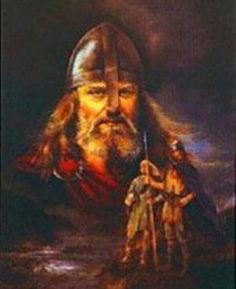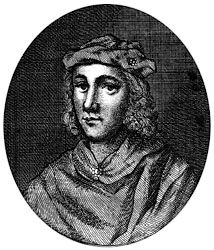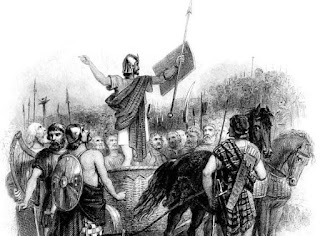The Lost Island
In search of Hinba
It's perhaps as important as lona - but where is it? The location of the island of Hinba is one of the great mysteries of Scottish history. Hinba is mentioned in Adomnan's Life of Columba in connection with some of the most significant episodes in the saint's life. It was there that the Holy Spirit appeared to Columba in the form of a divine vision, commanding him to ordain Aedan mac Gabrain as king of Dal Riata. He was also told many secrets, made clear on the obscurities of Scripture, and allowed to see into the past and future.
The saint received some of his most prestigious visitors on Hinba including four Irish saints for whom he celebrated mass there. But Hinba also had its darker side.
The island was used by the early Christians as a penitentiary. During one visit to the religious recluses there, called anchorites, Columba ordered that they be allowed an indulgence of food. To his displeasure, this was refused by one Neman mac Cathair. The saint predicted that Neman would then leave the penitentiary and be found with robbers eating mare's flesh in a wood.
Columba was nearly murdered on Hinba by an outlaw known as Lam Dess or Right Hand. Excommunicated for some woeful wrongdoing, Right Hand sought revenge. But the saint managed to evade his efforts to kill him. In a chilling epilogue, Columba's power of second sight allowed him to witness from Iona the death of his foe on a nearby island a year later.
The settlement on Hinba was among the earliest by Columba, and he may even have set up a monastery on Hinba before lona, But if Hinba is so startlingly important.
why does its location remain a mystery?
The simple answer is that the island's Gaelic name, Hinba, has long since disappeared and scholars have been unable to conclusively link it with any present day islands. Any attempt to identify Hinba therefore requires a serious amount of historical detective work.
We know. Hinba almost certainly now goes by a Norse name, which isn't very helpful when we consider how many Hebridean islands now have Viking names, but we can easily eliminate those islands to which Adomán gives other names. These include Skye and Islay.
Columba moved freely between Hinba and lona and his elderly uncle, Ernan, also managed the journey. This surely tells us that Hinba is quite near lona, especially when we consider that longer voyages would have seen Columba and the other early hermits, saints and voyagers having to fight their way across towering seas in tiny vessels made from animal skins known as coracles.
Around 574 AD Columba left Hinba for lona to crown Aedan mac Gabrain. Aedan set out to meet him either from Dunadd in Argyll or Kintyre, to the south. An enormous coastal peninsula of varied terrain, this hotly-disputed area later became an almost constant battleground in the war between the MacDonalds and the Campbells.
We might then conclude that Hinba couldn't be any islands that lie between lona and Aedan's mainland starting point, such as Jura or Scarba, as surely Columba would have just waited for Aedan there?
Highland historian John Lorne Campbell reckoned Hinba to be Canna, a little island to the south of Skye which forms part of the group known the Small Isles. But we know from Adomnán that Hinba could be an impossibly stormy voyage from Eigg, one of the other Small Isles, suggesting that Hinba was much further from Eigg than Canna.
In any case, we shouldn't try to deduce too much about Hinba's location from the Aedan episode. Iona could have been specifically chosen for Aedan's coronation.
If we look again at the area south of lona, Columba's meeting with the four Irish saints is a strong indication that Hinba lies on the sea route between Ireland and lona.
There is also a crucial piece of topographical evidence to be considered. Adomnán states that Hinba had a highly prominent sea bay, Muirbolc Mar, with a Christian settlement nearby. Any candidate has to satisfy this description, leaving us with two possibilities, both south of lona.
One is Jura. This bullet-shaped island has the wildest terrain of any inner Hebridean island and is famous for three conical mountain peaks known as the Paps of Jura. Another striking feature is Loch Tarbert, an incision-like inlet which is several miles in length and has an early Christian chapel nearby.
The other and perhaps more likely, candidate is Oronsay. It is joined to Colonsay at low-water by a tidal strand forming a deep bay, and is more on the direct sea route from Ireland than Jura.
Inhabited for some 7,000 years, Oronsay has an abundance of early relics, some linked to Columba, including the Sanctuary Cross which sits on the sands between the two islands.
Oronsay has a fine ruin in the shape of a beautiful 14th-century Augustinian Priory, thought to stand on the site of an earlier monastery established in 563, though this has yet to be proven. Archaeologists could solve the mystery by finding early-Christian remains at Oronsay Priory.
Even if the case for Oronsay remains inconclusive, the importance of Hinba- wherever it lies – must not be overlooked. For it was there that Columba's death was foreseen in a vision of angels bearing the great man's soul to heaven from lona.
Seil Island
The island of Seil lies to the north-east of the Gravellachs and close to the mainland. Rae (2011) has suggested it as possible location of Hinba on various grounds. These include its association with Brendan, its location on an inshore trade route from Antrim to the north, and its suitability for a substantial settlement.
He suggests that the Muirbolcmar could refer to the Seil Sound and narrows at Clachan Bridge where the "bag" captures the rapidly flowing water that floods under the bridge and also argues for this location on etymological grounds. Equating "Hinba" with the Gaelic Inbhir, he notes that the adjacent mainland parish of Kilninver means "church of Inbhir" and suggests that the derivation of "Seil" may be of Scandinavian origin with similarities to the East Frisian place name Zijl or Syl meaning a "seep or passage of water".
This, he proposes, could have been a Norse interpretation of Hinba/Inbhir. However, Mac an Tàilleir (2003) notes that Kilninver or Cill an Inbhir "appears to mean 'church by the river mouth', although an older form of Cill Fhionnbhair, 'Finbar's church' also appears.
It has also been proposed that Seil may be the Innisibsolian referred to in the Chronicle of the Kings of Alba, which records a victory of the Scots over a Viking force during the time of Donald II in the 9th century.
Innisibsolian is of Goidelic origin and if Solian is derived from 'Seil' as this early date it is hardly likely to have had a different Gaelic name prior to the arrival of the Norse. Furthermore, although south of Iona, Seil is not on a direct route to Iona from Ireland and there are very strong tides in this area.
In search of Hinba - Robert Rae - Seil Island














Comments
Post a Comment